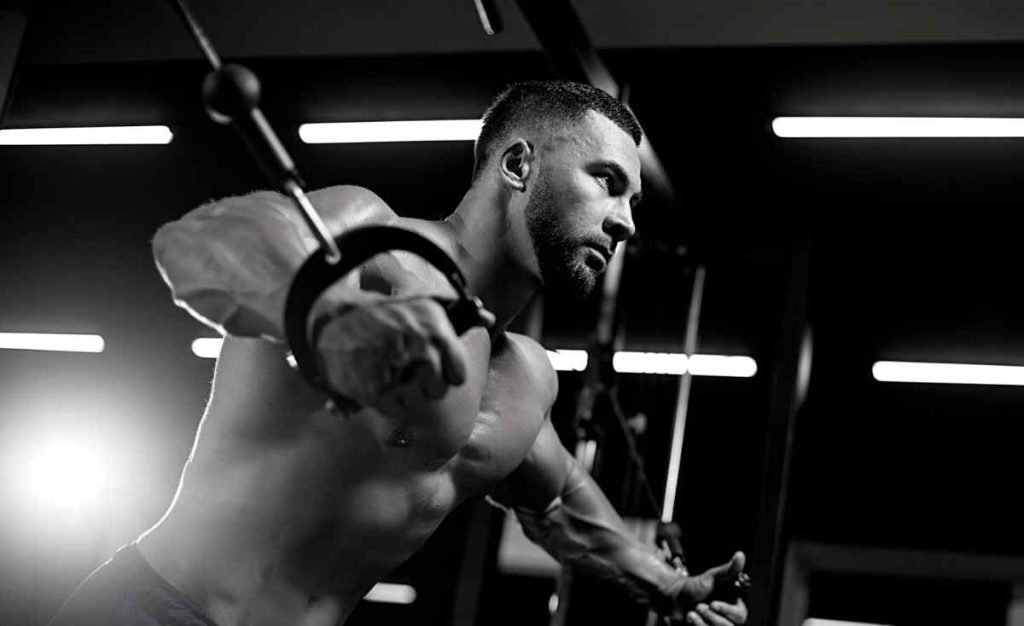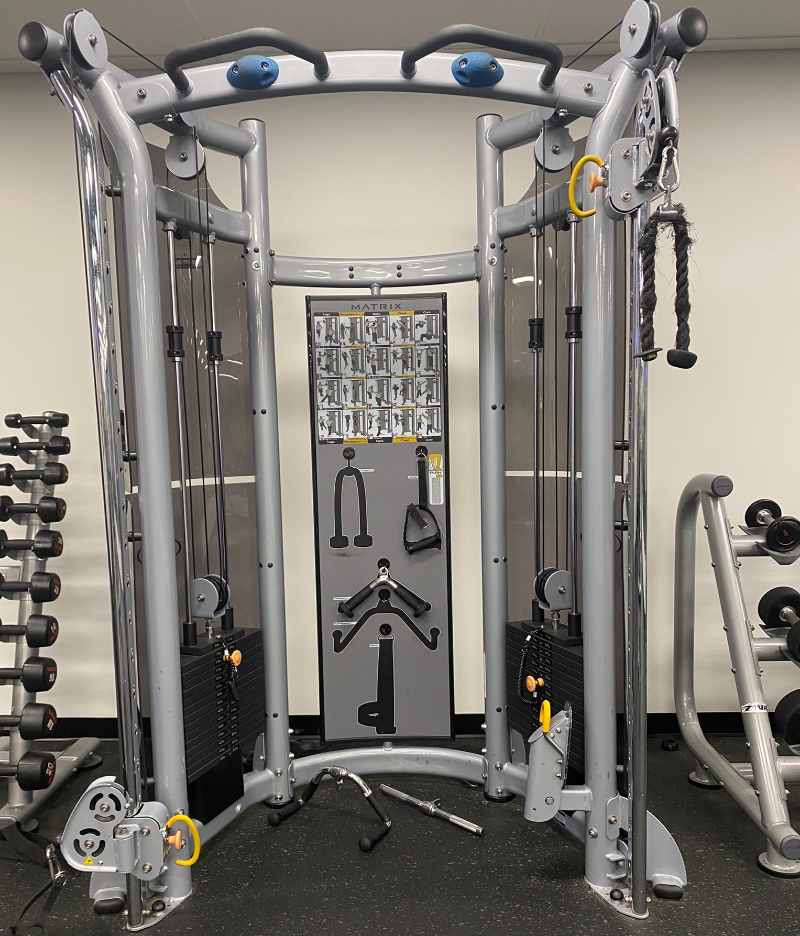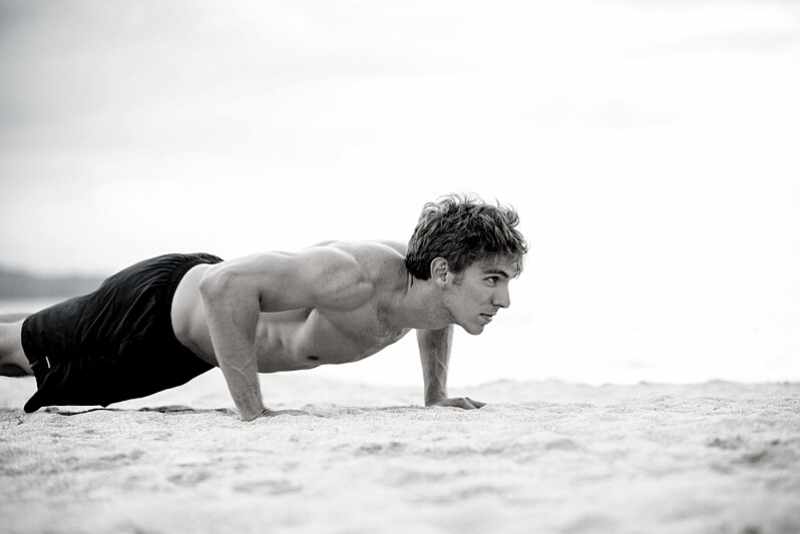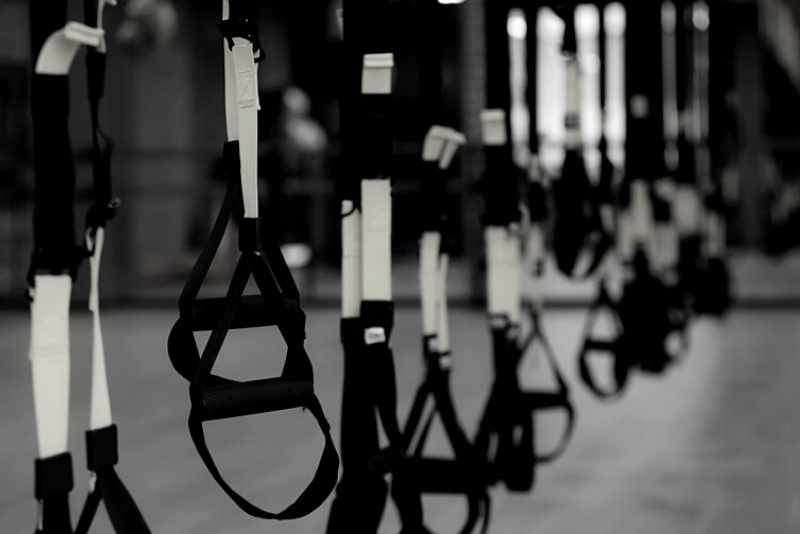The cable crossover is a killer exercise for developing upper body strength. Here are some cable crossover alternatives for cranking up chest day.

Cable crossovers are one of the all-time BEST exercises you can incorporate into your cable chest workout.
Not only do they increase time under tension for your chest muscles, but they allow you to target your inner pectoral muscles more effectively while still allowing for greater freedom of movement in your shoulder and elbow joints.
They’re incredibly beginner-friendly, too, and they’re an easy exercise to master.
But what if you don’t have a cable machine in your home gym, or the cable machine at your gym is occupied (which, let’s be honest, it often is)? How can you get a proper chest workout without being able to do cable crossovers?
That’s what we’re going to find out below!
In this article, I’ll talk about cable crossover alternatives, explaining what to look for in suitable replacement exercises and how to nail each one for a truly kickass chest workout.
Read the entire page to the end for some useful answers to commonly asked questions that will give you greater insight into how you can maximize the effectiveness of your workout even if you can’t do cable crossovers.
What Makes a Good Cable Crossover Alternative?
To understand what makes a good cable crossover alternative, we have to first understand what, exactly, a cable crossover does.
The cable crossover engages the sternal (lower) heads of your pectoral muscles, and specifically targets the inner chest muscles. They also lead to some shoulder, back, and ab engagement throughout the range of motion.

Really, the only exercises that recruit more of your chest musculature are bench presses and dumbbell flys.
What this means is that cable crossovers are a truly effective solution for building powerful chest muscles.
When looking for cable crossover alternatives, your goal is to find exercises that:
- Engage your chest muscles as effectively, including the sternal heads and inner chest.
- Recruit your triceps and shoulders in the same range of motion as cable crossovers
- Work your right and left arms together yet independent of each other
Luckily for you, there are a lot of excellent exercises similar enough to cable crossovers that make wonderful alternatives.
Best Cable Crossover Alternatives
1. Push Ups
Let’s be honest: you had to know this was coming, because nothing is quite as effective for building chest muscles as push-ups!
Push-ups utilize your body weight and work the exact same muscles as cable crossovers.
Granted, they’re less focused on the inner chest and more on the outer chest muscles, but that’s easily fixed by sliding your hands closer together (to do, for example, diamond push-ups).

They also recruit the most amount of muscle, making them the best for building real mass and strength.
To perform this exercise:
- Get on your hands and knees. Extend your legs out behind you into “Plank” position, with your body parallel to the ground, butt tucked in, and core tight.
- Bend your elbows to lower your entire body toward the floor. Resist the urge to dip your head or let your hips droop. Keep your body in a tight, straight line.
- Lower until your nose nearly touches the floor.
- Exhale as you push back up. Push until your arms are almost fully extended—stop before locking out your elbows.
- Pause at the top for a 1-count, and inhale as you lower.
- Repeat as desired.
2. Machine Pec Flys
Machine pec flys are virtually identical to cable crossovers in all the ways that matter.
They require a specific pec fly machine (which is typically available in most gyms) and allow you to focus on your inner chest muscles (particularly at the end of the movement, when you squeeze your arms together).
The beauty of the machine pec fly is that you can do it with the exact same form as cable crossovers (arms fully extended), or you can bend your elbows to focus more on the inner chest.
You’ve got options that let you specifically target certain aspects of your chest muscles and engage your shoulders and triceps most effectively and safely.
To perform this exercise:
- Sit on the pec fly machine. Set the handles to your desired height, and adjust the weight as desired.
- Grip the handles with your arms nearly straight. Allow for a slight bend in your elbows, and lift your elbows in line with your arm to maximize engagement of the chest and shoulders.
- Exhale as you push the handles toward each other in front of your chest. Push until your fingers just touch, which increases focus on the inner chest.
- Control the movement of the machine as you allow it to swing outward once more. Focus on moving slowly through the eccentric phase of the fly.
- Stop when your arms are fully spread out, pause for a 1-count, then inhale as you push inward once more.
- Repeat as desired.
3. TRX Strap Push-ups
TRX Strap push-ups are basically cable crossovers in reverse. Instead of pushing against handles directly in front of you to lift the weight secured to the handles, you’re pushing against handles directly in front of you to lift the weight of your body in a push-up.
It’s a slight variation that can help you to develop more functional strength. It will also work your muscles in almost exactly the same way cable crossovers do.
One excellent bonus of TRX push-ups: they’re amazing for building core strength.

Because you’re supporting your weight on the bands (which can swing and move, thus forming a very unstable platform), your core muscles (abs, lower back, obliques, and even your glutes) have to engage to maintain stability.
Plus, you can increase or decrease the difficulty of the exercise simply by changing the angle at which you do the push-ups. A game-changer, I guarantee it!
To perform this exercise:
- Grip the handles of TRX straps, and face away from the bands’ anchor point.
- Plant your feet together and lean forward until you’re supporting the weight of your body against the handles at the desired angle.
- Start with your hands placed directly by your armpits, simulating the bottom of the push-up.
- Exhale as you push against the TRX strap handles.
- Push your body upwards and bring your hands close together in front of your chest.
- Inhale as you lower (slowly, and controlling the straps) back down to your starting position, with your hands beside your armpits.
- Pause for a 1-count, and exhale as you push up once more.
- Repeat as desired.
Trainer’s Note:
Test various angles to find which you’re currently capable of handling based on your fitness level and strength.
One of the benefits of TRX straps is the ability to use varying grips.
4. Dumbbell Flys
Dumbbell flys work your chest muscles the same way cable crossovers do, but utilize dumbbells rather than the cable machine.
They’re the “original flys” and require nothing but a pair of dumbbells and a bench, making them one of the best options for home-based workouts if you don’t have space for a cable machine.
They’re more effective at working the outer chest than inner chest, but they do recruit the same muscles as cable crossovers.
To perform this exercise:
- Grip a pair of dumbbells and lie back on a bench. Bring the dumbbells up to starting position by extending your arms so the weights are directly over your chest.
- Bend your elbows slightly and turn them outward as you spread your arms wide.
- Inhale as you lower the weight, lowering to roughly the level of your chest.
- Exhale as you push back up, bringing your (straight) arms together once more directly above your chest.
- Pause at the top for a 1-count, then inhale as you open your arms once more.
- Repeat as desired.
5. Banded Crossovers
Banded crossovers are the resistance band-based alternative to cable crossovers. They lead to the same increased time under tension, go through the same range of motion, even engage your muscles the exact same way.
You will need a solid anchor point at roughly head height, and enough bands to generate sufficient resistance to push against.
But you’ll find that this exercise is almost identical to cable crossovers in all the best ways.
To perform this exercise:
- Secure your resistance bands to an anchor point at roughly head height.
- Grip one end of the band in each hand, and turn so you are facing away from the anchor point.
- Step your right foot forward slightly, bend your knee, and lean slightly forward. Bring your hands to the “starting” point directly beside your armpits, with the resistance bands running over the outside of your shoulders.
- Exhale as you extend your arms and press the bands forward.
- Bring your hands together directly in front of your chest. Resist the urge to lock out your elbows, but keep them bent to maximize focus on your muscles.
- Inhale as you relax and return your hands to starting position.
- Pause for a 1-count, then exhale as you push once more.
- Repeat as desired.
6. Resistance Band Low Crossover
This exercise is another excellent variation on the cable crossover using resistance bands.
The real differences are:
- The anchor point, which is set to roughly chest height.
- Where your hands cross (in front of your belly rather than chest), which shifts the focus onto your lower chest as well as inner chest.
It’s a great way to spice things up and add a new twist to your Chest Day routine.
To perform this exercise:
- Secure your resistance bands to an anchor point at roughly chest height.
- Grip one end of the band in each hand, and turn so you are facing away from the anchor point.
- Step your right foot forward slightly, bend your knee, and lean slightly forward. Bring your hands to the “starting” point directly beside your armpits, with the resistance bands running over the outside of your shoulders.
- Exhale as you extend your arms and press the bands forward and downward.
- Bring your hands together directly in front of your upper belly. Resist the urge to lock out your elbows, but keep them bent to maximize focus on your muscles.
- Inhale as you relax and return your hands to starting position.
- Pause for a 1-count, then exhale as you push once more.
- Repeat as desired.
7. Alternating Dumbbell Fly
Last but definitely not least, an excellent variation on the standard dumbbell fly that will set your muscles ON FIRE.
Alternating the dumbbell flys means your chest, shoulder, and tricep muscles remain engaged longer (to support the inactive dumbbell), leading to greater time under tension overall. It’s an excellent “finishing move” to target muscular endurance as well as strength.
See also: 9 Reasons the Dumbbell Bench Press Kicks Butt
To perform this exercise:
- Grip a pair of dumbbells and lie back on a bench. Bring the dumbbells up to starting position by extending your arms so the weights are directly over your chest.
- Bend your elbows slightly and turn them outward as you spread your arms wide.
- Inhale as you lower the weight, lowering to roughly the level of your chest.
- Exhale as you push back up, bringing only your right arm directly above your chest.
- Pause at the top for a 1-count, then inhale as you lower your right arm once more.
- Once you reach the bottom, keep your right arm immobile as you bring your left arm up directly above your chest.
- Pause at the top for a 1-count, then inhale as you lower your left arm once more. You have now completed one repetition.
- Repeat as desired.
FAQs About Cable Crossover Alternatives
Can you do a cable crossover with dumbbells?
You can’t exactly mimic the way cable crossovers engage your muscles using dumbbells, but dumbbell flys are close enough that they make a suitable alternative to cable crossovers.
Are cable crossovers better than flies?
Dumbbell flies engage the chest, shoulder, and tricep muscles more effectively, overloading the muscle better and leading to fractionally better growth overall.
That said, cable crossovers help to build better mind-muscle connection and pay more attention to the way your muscles function throughout the entire range of motion.
The Bottom Line
Cable crossovers are an amazing option for building powerful chest, shoulder, and tricep muscles, and should be a staple of any cable-based workout.
However, if you don’t have a cable machine, the exercises above may be a great alternative to consider to still get a muscle-shredding workout using what you have on hand.
More Cable Machine Guides
How to Use a Cable Machine (a Beginner’s Guide). The cable machine is an incredibly versatile (and safe!) way to train at the gym. Here’s a detailed look at how to use a cable machine, best practices, and some of the top exercises you can do with it.
5 Best Cable Back Exercises (Plus a 20-Minute Cable Back Workout). Looking to get a killer back workout with a cable machine? Here are the best back exercises do to, the benefits of training back on a cable machine, and a sample 20-minute back cable workout.
5 Best Cable Machine Shoulder Exercises (Plus a Sample Workout). Training shoulders on a cable machine is an excellent way to increase time under tension and build more muscle. Here are the best shoulder exercises you can do with a cable machine and a sample 20-minute workout for those Boulder Shoulders.